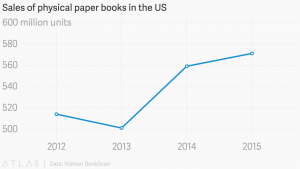 Sales of physical books in the U.S. edge up over 2014 levels.
Sales of physical books in the U.S. edge up over 2014 levels.
“For the last half decade, ever since digital books and e-readers first came on the scene, news headlines have been at war,” writes Amy X. Wang in Quartz. “The physical book is dead, some reports declared, while others vehemently argued for the eternality of the printed word.”
“Data, actually, supports the latter sentiment,” Wang continues. “At least in the US, sales of physical books have experienced a renewed surge of interest, according to Nielsen BookScan, a data provider that collects data on roughly 85% of the print market.”
Incidentally, I saw plenty of evidence of this last week, as we unwrapped gifts. Under the tree were two cookbooks, a gorgeous hardcover of Game of Thrones, two hefty puzzle books, a hilarious book on how to know if your cat is trying to kill you, plus a mystery story compilation that looks like it will take months to work through. Books were a much bigger thing this year in our family than they have been in the past few years.
The data shows that we probably weren’t alone. Wang reports that the Nielsen data showed 571 million paper books sold in 2015 (as of early December), “a modest but noticeable increase over the 559 million sold in 2014.”
Meanwhile, back in Kindle land, the e-book is struggling, Wang notes. “A Pew Research Center study in October found that fewer Americans are buying and using e-reading devices like Kindles and Nooks than they did in past years.”
Assuming these trends continue, Wang notes, 2016 might just be the year that the physical book makes—fingers crossed—a real comeback.
